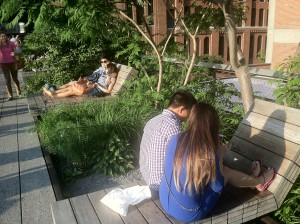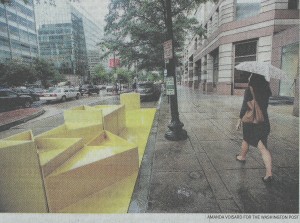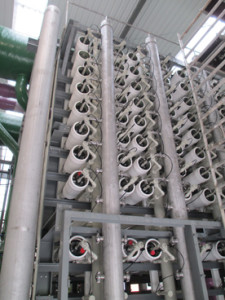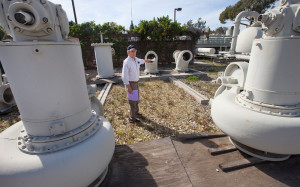Updates on Previous Posts – Curbed Relaxation and Drought

Near year’s end last I wrote about PARK(ing) Day. The other day The Washington Post featured a piece called “A ‘parklet’ parks itself on K Street NW. Subtitle: “To mixed reviews, District allows street meter spaces to become zones of relaxation.”
 Right is a “relaxing zone” recently observed on The High Line on Manhattan’s Lower West Side. But, the case for this post is metered parking spaces–at grade–in
Right is a “relaxing zone” recently observed on The High Line on Manhattan’s Lower West Side. But, the case for this post is metered parking spaces–at grade–in  a high-demand extremely pricy office district in downtown DC shown left. 2 parking spaces lost – take 5.
a high-demand extremely pricy office district in downtown DC shown left. 2 parking spaces lost – take 5.
The District government just began allowing the use of parking spaces as year-round handicap-accessible mini-parks, i.e., parklets. Interesting that DC law provides certain annual revenue must be achieved by parking meters so for the first couple of years, at least, the City will absorb the lost revenue for these.
Kinda figures that it’s located in front of the DC offices of Gensler, the global architecture firm. Two of its designers won an “internal competition” for the idea which includes bringing plants to it on Sundays.
The design’s modular yellow triangles are movable, and will be on occasion per visitor suggestions to the Gensler architects.
One person quoted in the article claimed the parklet will “bring a little touch of feng shui” while another groused: “This is a place of work. Why would you put a park here in all this traffic?”
Imagine the ubiquitous suit walking along with a Starbucks clutched in one hand, briefcase in the other, stopping to linger, and maybe meet another suit, while swallowing the rest of it? (They didn’t for world-renown violinist Joshua Bell, casually attired, including baseball hat, playing during rush hour near the top of a covered Metro station escalator just down the street.)
A valet car parker at for the adjacent Prime Rib steakhouse says the chairs put onto the parklet structure are used by customers waiting for their rides. Ironic, sorta…
 Another recent post was about the horrible drought in California and surrounds. And, there was a second one about drought consequences. Now comes a piece featuring the resuscitation of a long-shelved desalinization plant in Santa Barbara. Washington Post headline: “Thirsty Santa Barbara looks again to the sea.”
Another recent post was about the horrible drought in California and surrounds. And, there was a second one about drought consequences. Now comes a piece featuring the resuscitation of a long-shelved desalinization plant in Santa Barbara. Washington Post headline: “Thirsty Santa Barbara looks again to the sea.”
When recently visiting the abandoned control room of the plant, a city official remarked that it reminded him of the Dharma Initiative from the TV series “Lost”.
The desal plant went online in 1992. But, Providence intervened and rain returned to that coastal city so then abandoned very soon thereafer. $34M was invested back then. To restart, the tab is about $50M with annual ops pegged at $5M.
 And, of course the environmentalists are alarmed all over again, imagining all specie of marine life being sucked in the Goliathan pumps seen right.
And, of course the environmentalists are alarmed all over again, imagining all specie of marine life being sucked in the Goliathan pumps seen right.
With a projected re-start next year, the hope is to provide 30% of the city’s need by 2017. Piping extends into the ocean by about 3/4 mi. and the draw is planned for 7M gals/day.
It, coupled with 21 other desal plants operating in California today and another 17 proposed, are unlikely to make a dent in global sea rise. (Non sequitur.)
The article is dated 7/12/15 and may be found online if you want more, including a story about one Santa Barbara resident who’s installed a slightly unusual rainwater capture/store method on her property to water her avocado and other fruit trees. Grey water from her shower is saved for plant irrigation and household chores. Her water use has declined a lot.